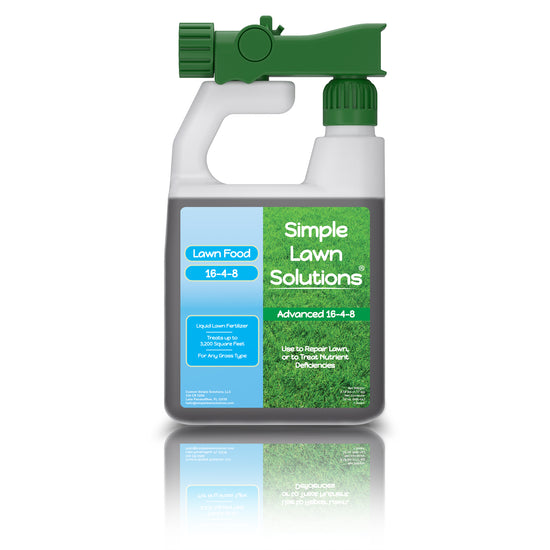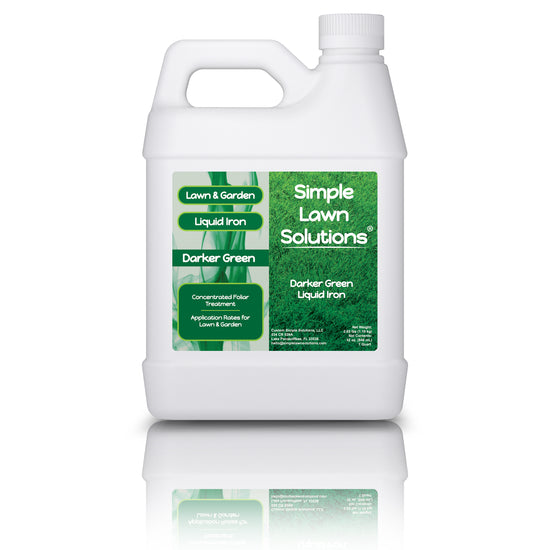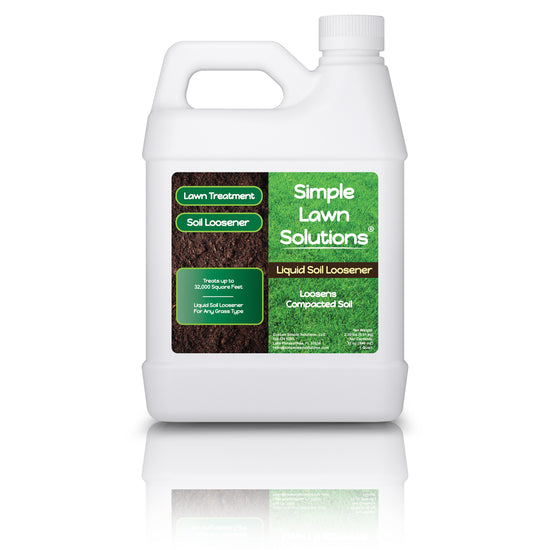Lawn care is no joke. You have to ensure you’re watering sufficiently, mowing frequently, applying your liquid lawn fertilizer on time, etc. You know that fertilizing lawns is one of the most important things to be doing, but nobody ever taught you the right time to do it! Fear not – we’re here with the lawn solutions you’re looking for.
Before you start fertilizing lawns…
Before you jump into fertilizing lawns (whether your own, for your grandmother, or a business), the most important thing to note is what type of grass you're dealing with: warm-season or cool-season grass.
If you’re not sure, once again, we have a lawn solution for you. Here's a map that can help guide you in the right direction.
Some general “fertilizing lawn” facts
If you’re not sure when or how often you should be fertilizing lawns and you want to know the basics, generally adding fertilizer once or twice a year is perfect. It is vital to do this during the season that your grass is growing the most. Typically, across the board, this is in the 60-80 degree weather range. When selecting a fertilizer, the best lawn solution is to ensure it has all the right macronutrients you need for lawn care.

Types of warm-season grass
Bahiagrass
Bahiagrass is incredible in that it thrives in the heat, meaning you don’t have to worry about it in a drought. That doesn’t mean it doesn’t come with its own set of problems, though. Bahiagrass has coarse, pointy blades (so it’s not the most comfortable to walk on), numerous seed heads, and lawns of bahiagrass are known for weed infestations.
Bermudagrass
Bermudagrass is strong and durable. It can handle the heat, drought, and foot traffic; however, it is sensitive to cold temperatures. There might be a lack of growth when the temperature drops, but once it heats back up again, bermudagrass lawns grow rapidly. Bermudagrass is so tough, that it is considered a difficult weed to control, in areas where it is not wanted. Bermudagrass is a sun-lover and generally grows poorly in shaded environments.
Centipedegrass
Centipedegrass is different from bermudagrass in that it grows slowly and can be incredibly low maintenance. Centipedegrass tolerates drought but may require irrigation to remain green and vigorous. Although less drought-tolerant, centipedegrass exhibits better cold tolerance than St. Augustinegrass or bahiagrass.
Zoysiagrass
Zoysiagrass is the first to turn green and the last to go brown. It can survive through hot and cold weather, but it is still definitely a warm-season grass. The biggest thing to note if you have zoysiagrass is that thatch removal can be important for a vigorously growing, aesthetically-pleasing lawn. This grass is one of the most shade-tolerant, warm-season grasses.
Buffalograss
Buffalograss combines awesome heat and drought tolerance, with cold-tolerance superior to that of other warm-season turfgrasses. Buffalograss does not grow as vigorously as bermudagrass but is a great low-maintenance turf option. It is also the only commonly used turfgrass that is native to the United States. Buffalograss does love the sun and generally does not do well in shady environments.
Your warm-season grass schedule
January
Happy New Year, warm-season grass owners! Make sure you’re preparing for lawn care by implementing the earliest lawn solutions you can. This includes cleaning and sharpening your lawn tools, edging your grass, and taking soil samples. Preparing for things such as fertilizing, mowing, and aerating is just as important as doing them.
February
Love is in the air…and weeds are in the grass – yuck! Apply your herbicides and spot-treat by pulling any weeds you might see. In the spirit of cleaning, check your lawn for debris, twigs, and stones before spring rolls in so your lawn will be easier to manage when the time comes.
March
With the luck of the Irish combined with your location, your grass may start growing around this time. Mow that lawn! It's crucial to cut slightly lower than usual the first few times. Ensure your soil pH is balanced and get rid of any unwanted moss that might have made its way to your lawn in the cooler, damper months.
April
Seed, seed, and overseed, if needed! As the temperature heats up, your warm-season grass will enter active growth due to soil temperatures also rising, meaning if you need to plant, lawn solutions point to now being the time to do it. Continue to mow, but now at normal heights.
May
Aerating and dethatching your lawn reduces compaction, improves drainage, and reduces lawn disease risks.
June
Fertilizing lawns is what it’s all about in June for warm-season grasses. Every 4-8 weeks in the summer, be sure to be fertilizing lawns with either liquid or granular lawn food. At Simple Lawn Solutions, we recommend our liquid lawn fertilizer because, in every drop, you get a perfect balance of nutrients.
July
When July rolls around, warm-season grasses should be cut about 1 to 1 ½ inches above standard recommended heights. This is because taller blades shade the soil, trapping water, and fighting off weeds.
August
Now that we’ve come to the end of summer, mow your lawn only as needed rather than on a fixed schedule. Be sure to keep fertilizing lawns to increase energy stores for winter. Your final feeding should be scheduled for about 6-8 weeks before the first expected frost.
September
Hello, autumn! Now that fall has hit in the south, rain is bound to increase. This means you should slow down your watering so as not to drown your lawn. Spray pre-emergent herbicides before cool-season weeds germinate, and overseed when your warm-season grass begins losing its color.
October
Before the trick-or-treaters make their way to your lawn, make your final cuts! Mow until the grass stops growing, and keep that mowing height up. Higher mowing heights equal more leaf area for photosynthesis, increasing the amount of food stored for regrowth in the spring. Make any soil corrections before winter hits.
November
Evaluate if you need to continue to fertilize, and spot treat as you see weeds pop up. One of the most significant lawn solutions at this time of year is to rake and remove fallen leaves unless you decide to mulch them. If you leave the leaves be, you risk disease and trap airflow.
December
Living in the south, you most likely won’t have snow (lucky you!). Because of that, you can still water your lawn. Remember, dial the water way back as growth potential and evaporative demand are reduced during this time.

Types of cool-season grass
Fine fescue
Fine fescue is a cool-season grass that is thick and textured. Its blades are very upright, rarely sway, and tend to clump together. Fine fescue is a medium to dark green grass that doesn’t fare well when put up against heavy use and traffic. Fine fescues have great drought tolerance for cool-season grasses but do not display vigorous growth characteristics.
Kentucky bluegrass
Nope, we’re not talking about bluegrass, the music genre! Kentucky bluegrass is somewhat of an oxymoron grass as it grows in cooler seasons but thrives in direct sunlight. It gets its name from its color, as the dark green can sometimes appear dark blue. With enough sun and water, bluegrass provides a lush, barefoot pleasing lawn.
Perennial ryegrass
Perennial ryegrass is a great grass to establish a lawn from seed in a very short time. Perennial ryegrass can be tough on mowers and is often used in seed blends, found with Kentucky bluegrass and fine fescues. Poor cold tolerance makes this grass less appealing for use in the far north.
Traditional tall fescue
Traditional tall fescue is much coarser than fine fescue, and its blades have a point similar to perennial ryegrass. Tall fescues display great drought tolerance for cool-season grasses and can do well in the heat. Breeding efforts have resulted in better cultivars, generally referred to as turf-type tall fescue.
Turf-type tall fescue
This grass is a legendary type of grass! It can withstand heat, survive droughts, and thrive in the shade, making it a great lawn solution! Due to its growth habit, turf-type tall fescue is actually short (what do you know!), and it is dark green and sharp. This grass, like ryegrass, has poor cold tolerance and is generally not great for use in the far north.
Your cool-season grass schedule
January
And now, happy New Year to you, cool-season grass owners! Unlike the warm-season grass people, you’ll need to break out the de-icing salts this month. Be careful, though, as salt buildup can damage the soil. In addition, prepare your lawn tools and avoid too much foot traffic on frozen grass.
February
This month, our biggest lawn solution for you is to flush salt-impacted or pet-stressed (yes, we mean where your dog was walking and doing their business all winter) areas with water as soon as the soil thaws enough. This reduces potential damage.
March
Just because it’s the first month of springtime doesn’t mean it’s time to start fertilizing lawns. As northerners know, spring weather often begins much later than the first official day of spring. In March, you should simply rake your lawn to remove any debris and dead grass.
April
By now, you should notice the first signs of growth in your lawn. Start mowing! When you do, keep the grass a little shorter than usual. Repair any bare lawn spots that you might see, and seed before summer gets here.
May
Spring is officially in full force, meaning you can mow at normally recommended heights. If you want improved soil and added nutrients, the lawn solution for you is to leave lawn clippings on the grass. Spot treat your weeds and start fertilizing lawns.
June
Because your grass is more apt to cooler seasons, it’s important to provide your lawn with 1 inch of water per week (including rainfall) once summer hits. Raise your mowing heights to 3-4 inches to shade roots and encourage heat resilience.
July
Continue watering and mowing thoroughly, but never remove more than 1/3 of the blade in a single mowing.
August
August is an important month in the life of cool-season grasses. As your grass approaches its primary growing season, your soil needs to breathe.
August is all about overseeding to prevent thinning lawns. Ideally, this is done about 45 days before your area’s first frost.
September
Fertilizing lawns with cool-season grasses in September is extremely important. Your grass should be fed about 6 weeks before the first anticipated frost. You should also gradually lower your mower blades to regular mowing heights at this point.
October
What’s spookier than a suffocated lawn? We’re not sure of anything! That’s why your October lawn solution should be to mulch or collect fallen leaves! If you don’t, un-raked leaves can become very heavy, suffocating your beloved grass.
November
If you’re in an area where your lawn is still growing, then continue to mow until it stops. Your final mowing should be just a little bit lower than normal so that snow mold risks are reduced. In addition, keep watering if need be. Grasses should enter winter hydrated.
December
Leave your lawn be this month. Try to limit any foot traffic so that snow isn’t compacting the ground. Clean and store your tools until it’s time to do it all over again!
Navigating a lawn care schedule, particularly a fertilizing schedule, can be challenging. That is why we’re here to help! Follow these guidelines, and make adjustments as you see fit to create your own lawn solutions! Remember, each type of grass most likely needs something different than another type, so don’t get too hung up on following each step exactly.
Want to learn more about lawn care? Is fertilizing lawns still too overwhelming? Feel free to reach out! We love chatting with our customers and figuring out the best product or method for their lawn.










8 comments
hello, just got the simple lawn solutions – lawn energizer, when should i apply it and how much of it? i live in north new jersey, your website said it will work in the summer time.
thanks
mike
Do you have a list of products that need to be used at a certain month for Illinois? Thanks
Hello Ben,
We need more information regarding your lawn, please send us an email at hello@simplelawnsolutions.com and we will be more than happy to provide you a personalized lawn care plan.
best time to spray for weeds? aerate? My soil is very sandy and we have a lot of weeds mixed in our cool season grass mix :( zone 1a
Hello SDL, thank you for commenting. We would recommend fertilizing no more than 4 weeks apart during the growing season. If you have any additional questions please reach out by email hello@simplelawnsolutions.com